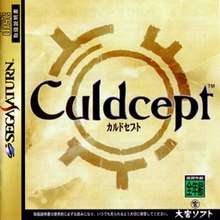Culdcept
Culdcept (カルドセプト, Karudoseputo) is a turn-based strategy video game. It has drawn comparisons to other modern strategy titles, and also shares features with non-video games Monopoly and Magic: The Gathering. The first installment to reach North America was the expanded port of Culdcept Second released for the Sony PlayStation 2, the North American release was simply titled Culdcept. The first game was initially released only in Japan for the Sega Saturn and PlayStation, but was ported to the Nintendo DS in 2008 as Culdcept DS.
| Culdcept | |
|---|---|
 | |
| Developer(s) | OmiyaSoft |
| Publisher(s) | NEC Interchannel NIS America |
| Composer(s) | Takeshi Yanagawa Yuzo Koshiro |
| Platform(s) | Sega Saturn, PlayStation, PlayStation 2, Nintendo DS, Nintendo 3DS, PlayStation Portable, PlayStation 3 |
| Release | Saturn
3DS
|
| Genre(s) | Board game, Collectible card game |
| Mode(s) | Single-player, multiplayer |
On June 28, 2012, a Japan-only sequel, Culdcept 3DS was released on the Nintendo 3DS, followed by Culdcept Revolt on July 7, 2016 in Japan (October 3 and October 6, 2017 for North America and Europe respectively) on the same system.
Gameplay
In Culdcept, the player takes on the role of a Cepter. Cepters are beings that have the ability to use magical cards to summon creatures, cast spells, and perform various other feats of wizardry. As players advance through the game, they earn additional cards that they can use to create customised "books" (decks of 50 cards) with which to better defeat their foes.
Although the game is relatively intricate, it slowly nurtures the player through basic game concepts. By acting as an arbiter and automatically enforcing the rules, game complexity is kept to manageable levels. After enough sessions, players should be able to figure out various strategies and be able to effectively practice deck optimization techniques.
Mechanics
Gameplay resembles Monopoly in that players roll a die (or two dice with certain spells) to move around on a game board. However, instead of buying the property and putting houses and hotels on it, players instead summon a creature to defend the property with cards—the Magic: The Gathering aspect of the game. If an opponent lands on a property that one owns, the opponent either pays a toll, or can choose to attack the defending creature with one of their own in order to attempt to take over the property. Unlike Monopoly, this can result in one losing a piece of land after considerable investment.
There are four property colors that represent different terrain types, e.g. green = forest. The more a player invests in the property to "level it up" (ala adding houses or a hotel in Monopoly), the more the terrain flourishes (e.g. forests become more dense with trees). This then provides additional defense to creatures of the matching color type, and exacts a higher toll on opponents landing there. And as a player collects more lands of the same color (creating "chains") the tolls, as well of the land values, increase.
Culdcept also includes item cards that can be played during battle to help attack, defend, or manipulate the battle in a number of other ways. Along with creature and item cards are spell cards that cause other various effects to creatures, territories, and Cepters.
Related products
Culdcept is the first in a series of games by OmiyaSoft, originally released for the Sega Saturn. Two expansions were released on the PlayStation in 1999 and 2000 respectively. These expansions contain the original game, plus additional maps. A sequel titled Culdcept Second was released on the Dreamcast in 2001, with an expansion of its own released on the PlayStation 2 the following year. The sequel was marketed in North America as Culdcept, and published by NEC Interchannel. This expanded version brings the 10 original Saturn maps into the new engine.
On April 6, 2006, it was announced that a new entry to the series, Culdcept Saga, was in development. This new Xbox 360 title was released later that year in Japan, with a North American release on February 5, 2008. A Nintendo DS version, Culdcept DS was released in Japan on October 16, 2008.
On June 28, 2012, a Japan-only sequel, Culdcept 3DS was released on the Nintendo 3DS,[1] followed by Culdcept Revolt on July 7, 2016 on the same system.[2] Culdcept Revolt, unlike its predecessor, received a localization and was published by NIS America on October 2, 2017.
Manga
Also available are a series of manga books based on the original Culdcept game. The manga for Culdcept is about an apprentice Cepter named Najaran (with her worrywart talking staff, Goligan) who helps save the Culdcept, the book which the goddess Culdra had kept all the cards in until the War of the Gods. The manga was adapted by Shinya Kaneko and serialized in Japan by Kodansha in Magazine Z, and collected in six bound volumes. It is licensed in English by Tokyopop.
Reception
On release, Famitsu magazine scored the 1999 PS1 expansion of the game a 35 out of 40.[3]
References
- "カード紹介|カルドセプト". Nintendo.com. Retrieved 2020-04-21.
- "「カルドセプト リボルト」、新能力「秘術」や「密命」などを公開". Game.Watch. Retrieved 2020-04-21.
- プレイステーション - カルドセプト エキスパンション. Weekly Famitsu. No.915 Pt.2. Pg.8. 30 June 2006.